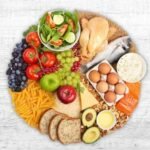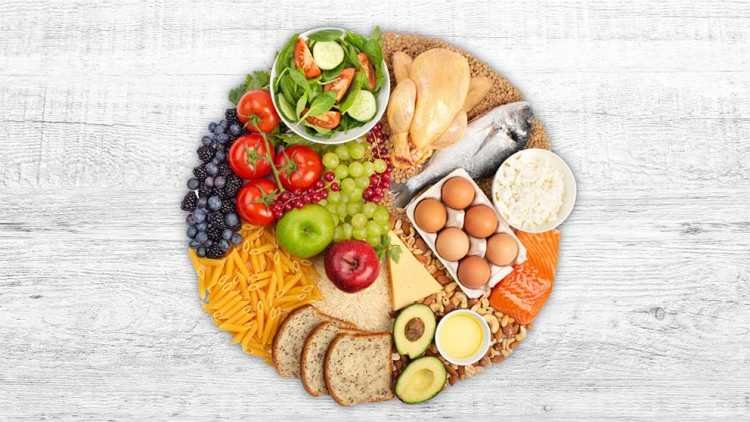Choosing healthy food options every day doesn’t have to be complicated. With the right knowledge and a few simple strategies, you can make smart, nourishing choices that support your overall health and well-being. Whether you’re looking to lose weight, improve your energy, or simply eat better, understanding how to select healthier foods is the key to success. In this article, we’ll guide you on how to choose healthy food options daily, focusing on balanced meals, nutrient-dense foods, and mindful eating habits.

1. Prioritize Whole, Unprocessed Foods
One of the best ways to choose healthy foods is to focus on whole, unprocessed foods. These foods are closer to their natural state, meaning they retain more of their essential nutrients. Fresh fruits, vegetables, whole grains, and lean proteins are all examples of whole foods that are rich in vitamins, minerals, fiber, and antioxidants.
Why it’s important:
- Whole foods are packed with nutrients that support your body’s natural processes.
- They are generally lower in added sugars, unhealthy fats, and preservatives.
- They provide lasting energy, help with digestion, and contribute to overall well-being.
Tip: Choose fresh fruits and vegetables whenever possible, and opt for whole grains like brown rice, quinoa, and oats over refined grains.
2. Incorporate Lean Proteins
Protein is essential for building and repairing tissues, supporting immune function, and maintaining muscle mass. When choosing healthy food options, prioritize lean protein sources like chicken, turkey, fish, eggs, legumes (beans, lentils), tofu, and Greek yogurt. These foods provide high-quality protein without the added fat that can come from fattier meats.
Why it’s important:
- Protein helps you feel full for longer, reducing hunger and cravings.
- Lean proteins are nutrient-dense and support muscle health.
- They contribute to a balanced, healthy diet without excessive calories.
Tip: Include a source of lean protein in each meal to keep you feeling satisfied and energized.
3. Eat More Vegetables
Vegetables are some of the healthiest foods you can eat, packed with vitamins, minerals, fiber, and antioxidants. Try to include a variety of colorful vegetables in your daily meals. Each color represents a different set of nutrients, so the more variety you include, the better.
Why it’s important:
- Vegetables are low in calories and high in fiber, which helps with digestion and weight management.
- They are rich in essential nutrients like potassium, vitamin C, and folate.
- Vegetables provide antioxidants that protect the body from inflammation and disease.
Tip: Aim to fill half of your plate with vegetables at each meal, and experiment with different cooking methods like roasting, steaming, or sautéing.
4. Choose Healthy Fats
Not all fats are bad for you. Healthy fats, like those found in avocados, nuts, seeds, olive oil, and fatty fish (salmon, mackerel, sardines), are essential for good health. These fats support brain function, heart health, and even weight management.
Why it’s important:
- Healthy fats are essential for absorbing fat-soluble vitamins (A, D, E, and K).
- They help regulate hormones, support brain health, and provide long-lasting energy.
- They keep you feeling full and satisfied, reducing the likelihood of overeating.
Tip: Replace unhealthy fats (like those found in processed snacks and fried foods) with healthy fat sources. Add avocado to salads or snacks, and cook with olive oil instead of butter.
5. Choose Whole Grains Over Refined Carbs
Whole grains like brown rice, quinoa, oats, and whole wheat bread are healthier options compared to refined carbohydrates, such as white bread and pasta. Whole grains retain their fiber and nutrients, which help stabilize blood sugar levels and improve digestion.
Why it’s important:
- Whole grains are rich in fiber, which promotes fullness and healthy digestion.
- They help regulate blood sugar levels, reducing the risk of spikes and crashes.
- Whole grains provide essential nutrients like B vitamins, magnesium, and iron.
Tip: Swap out refined grains for whole grains in your daily meals, such as choosing whole grain pasta or quinoa instead of white pasta.
6. Control Portion Sizes
Even healthy foods can contribute to weight gain or overeating if portion sizes are not controlled. Learning how to control portion sizes is key to making healthier food choices daily. Focus on eating balanced meals with appropriate portion sizes of protein, carbs, and fats.
Why it’s important:
- Controlling portion sizes helps prevent overeating and ensures that you’re not consuming excess calories.
- It promotes a balanced intake of nutrients without overloading your system with too much of any one food group.
- Portion control is essential for weight management and maintaining a healthy metabolism.
Tip: Use smaller plates and bowls to naturally reduce portion sizes, and listen to your body’s hunger cues to avoid eating out of habit.
7. Limit Added Sugars and Processed Foods
Many processed foods are packed with added sugars, unhealthy fats, and artificial ingredients. These foods can be high in calories while offering little nutritional value. To make healthier food choices, limit your intake of sugary snacks, sodas, and processed foods, which can contribute to weight gain, inflammation, and chronic diseases.
Why it’s important:
- Added sugars and processed foods can cause blood sugar spikes, which may lead to cravings, energy crashes, and weight gain.
- They often lack essential nutrients and provide empty calories.
- Limiting processed foods helps reduce your risk of developing health conditions like heart disease, diabetes, and obesity.
Tip: Choose whole fruit instead of sugary snacks, and opt for homemade meals made with fresh ingredients to avoid added sugars and preservatives.
8. Stay Hydrated
Drinking enough water is crucial for good health, but it’s often overlooked. Staying hydrated supports digestion, energy levels, and overall body function. Drinking water before meals can also help you control hunger and prevent overeating.
Why it’s important:
- Water aids digestion and helps your body absorb nutrients.
- Proper hydration improves skin health, energy levels, and mental clarity.
- Drinking water before meals can help curb your appetite and prevent unnecessary snacking.
Tip: Aim to drink at least 8 glasses (64 oz) of water daily. You can also hydrate with herbal teas or water-infused with fruits and herbs for variety.
9. Mindful Eating
Mindful eating is all about paying attention to what and how you eat. By slowing down, savoring each bite, and being present during meals, you can make healthier food choices and avoid overeating.
Why it’s important:
- Mindful eating helps you tune into your body’s hunger and fullness signals, preventing overeating.
- It encourages a healthier relationship with food and reduces emotional eating.
- Mindful eating promotes better digestion and allows you to enjoy meals more fully.
Tip: Take your time while eating, chew slowly, and pay attention to how your body feels before deciding to eat more.
10. Plan Your Meals in Advance
Meal planning is one of the easiest ways to ensure you make healthy food choices each day. By preparing meals ahead of time, you can avoid the temptation of fast food or unhealthy takeout. Plan your meals for the week, including breakfast, lunch, dinner, and snacks.
Why it’s important:
- Meal planning helps you control what goes into your meals, making it easier to make healthier choices.
- It saves time and reduces stress during the week, as you’ll already have meals prepared.
- Planning ahead helps you stick to your health goals and avoid impulsive food choices.
Tip: Dedicate a day each week to meal prep. Chop vegetables, cook grains, and portion out meals so you can easily grab healthy options throughout the week.
Conclusion: Making Healthy Food Choices Every Day
Learning how to choose healthy food options daily is all about making mindful, balanced choices. By prioritizing whole foods, incorporating lean proteins, healthy fats, and plenty of vegetables, you can create meals that nourish your body and keep you feeling energized.
Portion control, hydration, and reducing processed foods are also important steps in building a healthy, sustainable eating pattern. With meal planning and mindful eating, you’ll be able to enjoy delicious meals that support your long-term health goals.







